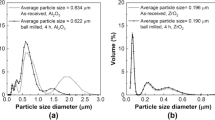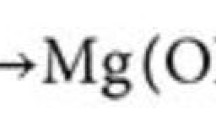Abstract
In this work, based on the sol-gel method combined with spray granulation technology, a novel process method to prepare Yttria stabilized ZrO2 beads with 5–50 µm diameter, 123 nm grains size, few pores, solid internal structure and well spherical type is proposed. These advantages can greatly improve the beads density, and decline the sintering temperature. The optimum preparation parameters, including sol and spray parameters, baking and sintering conditions, are obtained through the investigation of experimental conditions. The SEM test results of the surface and cross section morphologies show that the beads have solid structure and there is good consistency between the surface and interior of the beads. The average grain size of test results is about 123 nm. The XRD test results demonstrate that no monoclinic phase exists in the beads. The sintering temperature of the new process is only 1200 °C.

In this work, based on the sol-gel method combined with spray granulation technology, a novel process method to prepare Yttria stabilized ZrO2 beads with 5–50 µm diameter, 123 nm grains size, few pores, solid internal structure and well spherical type is proposed. These advantages can greatly improve the beads density, and decline the sintering temperature. The processes of the method mainly contain: sol preparation, spray forming process, organic compound discharging and sintering. The optimum preparation parameters, including sol and spray parameters, baking and sintering conditions, are obtained through the investigation of experimental conditions. The tested density result of the prepared beads is about 6.024 g/cm3 which is higher than for the traditional process. The SEM test results show that the diameter of the prepared Yttria stabilized ZrO2 beads is range from 5 to 50 µm with good sphericity. The surface and cross section morphologies show that the beads have solid structure and there is good consistency between the surface and interior of the beads. The average grain size is about 123 nm, no pores between grains. The XRD test results demonstrate that no monoclinic phase exists in the beads. The sintering temperature of the new process is only 1200 °C.
Highlights
-
A novel method to prepare Yttria stabilized ZrO2 beads with 5–50 µm diameter is proposed.
-
The optimum parameters of experiment conditions are studied and obtained.
-
The beads have characteristics of few pores, solid internal structure and well spherical type.
-
This process has low sintering temperature that is only 1200 °C.













Similar content being viewed by others
References
Gan XX, Song XM, Liu N, Dai HY (2018) Effects of grinding equipment and technological parameters on particle size of zirconia powder. Refractories 52:205–208
Wang MT, Chang CP (2008) Development and application of ZrO2 basen nono composite ceramics. China Ceram 44:45–47
Komatsu T, Ohta H, Motegi H, Hata JC, Terawaki K, Koizumi M, Muta K, Okano HJ (2021) A novel model of ischemia in rats with middle cerebral artery occlusion using a microcatheter and zirconia ball under fluoroscopy. Sci Rep 11:12806–12806
Motoyoshi K, Hiroko N, Yoshiko M (2008) Initial deposition rate of latex particles in the packed bed of zirconia beads. Colloids Surf A: Physicochemical Eng Asp 347:2–7
Noh Y, Lee YJ, Kim J, Kim YK (2022) Enhanced efficiency in CO2-free hydrogen production from methane in a molten liquid alloy bubble column reactor with zirconia beads. Chem Eng J 428:131095
Liu S, Tokura R, Thanh NM, Tsukamoto H, Yonezawa T (2020) Surfactant-stabilized copper paticles for low-temperature sintering: Paste preparation using a milling with small zirconia beads: Effect of pre-treatment with the disperse medium. Adv Powder Technol 31:4570–4575
Song DH, Kim JY, Kahng YH, Cho H, Kim ES (2018) Long-Term Effects on Graphene Supercapacitors of Using a Zirconia Bowl and Zirconia Balls for Ball-Mill mixing of Active Materials. J Korean Phys Soc 72:900–905
Jia GY, Zhang WR, Fan JL (2000) Development of low cost zirconia grinding balls, [J]. Mater Guide 14:74–75
Lv BW (2008) The preparation and study of ZrO2 grinding media ball, Shandong University of Technology
Walter M, Somers J, Fernandez A, Specht ED (2007) Structure of Yttria stabilized Zirconia beads produced by gel supported precipitation. J Mater Sci 42:4650–4658
Liu JL, Ma ZA, Pan JC, Wang CM (2019) Study on preparation of millimeter-sized alumina pellets by hot oil-drop method with pseudo-boehmite. Pet Process Petrochemicals 50:1–5
Guo T, Wang C, Dong LM, Lu JL, Liang TX (2020) Effect of Al2O3 on the Process Performance of ZrO2 Microspheres. J Wuhan Univ Technol 35:841–846
Li F, Li YH, Xu KW (2014) Research Progress of the Preparation of zirconia hollow sphere powder and the performance of its coating. Rare Met Mater Eng 43:3183–3187
Jiang F, Li S, Peng ZJ, Wang CA (2014) Fabrication of ZrO2 submicron hollow spheres with carbon templates. J Chin Ceram Soc 42:1087–1091
Wang SZ (1983) Research, design and application of granulation tower and granulation nozzle. Fertilizer Des 4.:71–90
Decent SP, King AC, Wallwork IM (2002) Free jets spun from a prilling tower, [J]. J Eng Math 42:265–282
Decent SP, King AC, Simmons MJH, Părău EI, Uddin J (2009) The trajectory and stability of a spiralling liquid jet: Viscous theory. Appl Math Model 33:4283–4302
Mu HY (2009) Study on preparation of zirconium sol by sol gel technology. Hebei Chem Ind 32:18–19+32
Li QX, Wang XF, Xu PP (2017) Effect of citric acid and acetic acid on the properties of zirconium sol. Refractories 51:143–145
Li K (2014) Numerical research on drop formation of rotating prilling sprayer, Zhengzhou University
Liu BQ (2019) Alumina microsphere synthesized by spray drying and its adsorbed properties, Dalian Jiaotong University
Liu W, Zhang HJ, Zhang WH (2009) Study on preparation technique and properties of zirconia wear resistant ceramic beads manufactured by a roll-forming method. Rare Met Mater Eng 38:198–201
Ji YM (2020) Study on roll-forming technology and performance of ZrO2 ceramic microbeads, Inner Mongolia University of science and technology
Li YF, Zhou ZW, Wang ZH (2021) Effect of speed sintering system on mechanical properties od Zirconia. J Oral Sci Res 37:339–343
Liu WD, Li JY, Ding R, Chang CP (2017) Test method for wear-resistance and impact-resistance of ceramic balls. Ceramics 6:22–26
Wei LW, Yang DY, Yuan HY, Cui JY, Wang ZF (2020) Effect of polishing time and sintering temperature on properties of alumina balls. Refractories 54:493–496
Garvie RC (1965) The occurrence of metastable tetragonal Zirconia as a crystallite size effect. J Phys Chem 69:1238–1243
Xu HL, Lu HX, Wang HL, Chen DL, Zhang R (2008) Preparation of tetragonal Zirconia’s powder. Chin Ceram 44:43–44
Yi ZZ, Shan K, Zhai FR, Li N, Xie ZP (2018) Structure and properties of thermal barrier coating prepared by alumina coated Zirconia composite powder. J Chin Ceram Soc 46:328–332
Peng DS, Wang XD, Ren YC, Du XQ, Dai ZH (2021) Synthesis of Yttria stabilized ZrO2-Al2O3 composite beads by wet titration technology. J Ceram Soc Jpn 129:753–760
Lv BV, Yan FQ, Chen DM (2007) Effect of sintering temperature on properties of zirconia wear resistant ceramic ball. Mod Technol Ceram 4:3–5
BW Lv, The preparation and study of ZrO2 grinding media ball, Shandong University of Technology, 2008.
Acknowledgements
We gratefully acknowledge the financial support from the Quanzhou science and Technology Bureau. We also thank the status of the Quanzhou Yunjian Measurement Control and Perception Technology Innovation Research Institute who gave much assistance for the paper’s experiments.
Author information
Authors and Affiliations
Corresponding authors
Ethics declarations
Conflict of interest
The authors declare no competing interests.
Additional information
Publisher’s note Springer Nature remains neutral with regard to jurisdictional claims in published maps and institutional affiliations.
Rights and permissions
About this article
Cite this article
Peng, D., Wang, X., Ren, Y. et al. Novel process of preparation of Yttria stabilized ZrO2 small sizes beads using sol-gel method combined with spray granulation technology. J Sol-Gel Sci Technol 103, 62–73 (2022). https://doi.org/10.1007/s10971-022-05782-4
Received:
Accepted:
Published:
Issue Date:
DOI: https://doi.org/10.1007/s10971-022-05782-4




